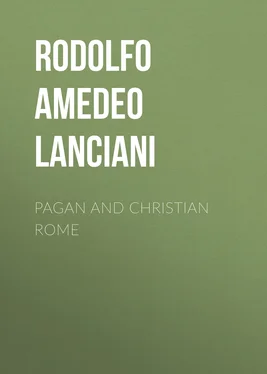Rodolfo Amedeo Lanciani - Pagan and Christian Rome
Здесь есть возможность читать онлайн «Rodolfo Amedeo Lanciani - Pagan and Christian Rome» — ознакомительный отрывок электронной книги совершенно бесплатно, а после прочтения отрывка купить полную версию. В некоторых случаях можно слушать аудио, скачать через торрент в формате fb2 и присутствует краткое содержание. Жанр: foreign_edu, История, История, на английском языке. Описание произведения, (предисловие) а так же отзывы посетителей доступны на портале библиотеки ЛибКат.
- Название:Pagan and Christian Rome
- Автор:
- Жанр:
- Год:неизвестен
- ISBN:нет данных
- Рейтинг книги:3 / 5. Голосов: 1
-
Избранное:Добавить в избранное
- Отзывы:
-
Ваша оценка:
- 60
- 1
- 2
- 3
- 4
- 5
Pagan and Christian Rome: краткое содержание, описание и аннотация
Предлагаем к чтению аннотацию, описание, краткое содержание или предисловие (зависит от того, что написал сам автор книги «Pagan and Christian Rome»). Если вы не нашли необходимую информацию о книге — напишите в комментариях, мы постараемся отыскать её.
Pagan and Christian Rome — читать онлайн ознакомительный отрывок
Ниже представлен текст книги, разбитый по страницам. Система сохранения места последней прочитанной страницы, позволяет с удобством читать онлайн бесплатно книгу «Pagan and Christian Rome», без необходимости каждый раз заново искать на чём Вы остановились. Поставьте закладку, и сможете в любой момент перейти на страницу, на которой закончили чтение.
Интервал:
Закладка:
Sample of a Drinking-cup.
Many drinking-cups used on these occasions have been found in Rome, in my time. They are generally works of the fourth century of our era, cut in glass by unskillful hands, and they show the portrait-heads of SS. Peter and Paul, in preference to other subjects of the kind. This fact is due not only to the special veneration which the Romans professed for the founders of their church, but also to the habit of celebrating their anniversary, June 29, with public or domestic agapai . S. Peter's day was to the Romans of the fourth century what Christmas is to us, as regards joviality and sumptuous banquets. On one of these occasions S. Jerome received from his friend Eustochio fruit and sweets in the shape of doves. In acknowledging the kind remembrance, S. Jerome recommends sobriety on that day more than on any other: "We must celebrate the birthday of Peter rather with exaltation of spirit, than with abundance of food. It is absurd to glorify with the satisfaction of our appetites the memory of men who pleased God by mortifying theirs." The poorer classes of citizens were fed under the porticoes of the Vatican basilica. The gatherings degenerated into the display of such excesses of drunkenness that Augustine could not resist writing to the Romans: "First you persecuted the martyrs with stones and other instruments of torture and death; and now you persecute their memory with your intoxicating cups."
The institution of public granaries ( horrea publica ) for the maintenance of the lower classes was also accepted and favored by Christian Rome. On page 250 of my "Ancient Rome," I have spoken of the warehouses for the storage of wheat, built by Sulpicius Galba on the plains of Testaccio, near the Porta S. Paolo, named for him horrea galbana , even after their purchase by the state. These public granaries originated at the time of Caius Gracchus and his grain laws. Their scheme was developed, in course of time, by Clodius, Pompey, Seianus, and the emperors, to such an extent that, in 312 a. d., there were registered in Rome alone two hundred and ninety granaries. They may be divided into three classes: In the first, and by far the most important, a plentiful supply of breadstuffs was kept at the expense of the state, to meet emergencies of scarcity or famine, and the wants of a population one third of which was fed gratuitously by the sovereign. The second was intended especially for the storage of paper ( horrea chartaria ), candles ( horrea candelaria ), spices ( horrea piperataria ), and other such commodities. The third class consisted of buildings in which the citizens might deposit their goods, money, plate, securities, and other valuables for which they had no place of safety in their own houses. There were also private horrea , built on speculation, to be let as strong-rooms like our modern vaults, storage-warehouses, and "pantechnicons."
The building of the new quarter of the Testaccio, the region of horrea par excellence, has given us the chance of studying the institution in its minutest details. I shall mention only one discovery. We found, in 1885, the official advertisement for leasing a horrea , under the empire of Hadrian. It is thus worded:—
"To be let from to-day, and hereafter annually (beginning on December 13): These warehouses, belonging to the Emperor Hadrian, together with their granaries, wine-cellars, strong-boxes, and repositories.
"The care and protection of the official watchmen is included in the lease.
"Regulations: I. Any one who rents rooms, vaults, or strong-boxes in this establishment is expected to pay the rent and vacate the place before December 13.
"II. Whoever disobeys regulation No. I., and omits to arrange with the horrearius (or keeper-in-chief) for the renewal of his lease, shall be considered as liable for another year, the rent to be determined by the average price paid by others for the same room, vault, or strong-box. This regulation to be enforced in case the horrearius has not had an opportunity to rent the said room, vault, or strong-box to other people.
"III. Sub-letting is not allowed. The administration will withdraw the watch and the guarantee from rooms, vaults, or strong-boxes which have been sub-let in violation of the existing rules.
"IV. Merchandise or valuables stored in these warehouses are held by the administration as security for payment of rental.
"V. The tenant will not be reimbursed by the administration for improvements, additions, and other such work which he has undertaken on his own account.
"VI. The tenant must give an assignment of his goods to the keeper-in-chief, who shall not be held responsible for the safe-keeping of merchandise or valuables which have not been duly declared. The tenant must claim a receipt for the said assignment and for the payment of his rental." 31
The granaries of the Church were intended only for the storage of corn. The landed estates which the Church owned in Africa and Sicily were administered by deputies, whose special duty it was to ship the produce of the harvest to Rome. During the first siege of Totila, in 546, Pope Vigilius, then on his way to Constantinople, despatched from the coast of Sicily a fleet of grain-laden vessels, under the care of Valentine, bishop of Silva Candida. The attempt to relieve the city of the famine proved useless, and the vessels were seized by the besiegers on their landing at Porto. In 589 an inundation of the Tiber, described by Gregoire de Tours, carried away several thousand bushels of grain, which had been stored in the horrea ecclesiæ , and the granaries themselves were totally destroyed.
The "Liber Pontificalis," vol. i. p. 315, describes the calamities which befell the city of Rome in the year 605; King Agilulf trying to enter the city by violence; heavy frosts killing the vines; rats destroying the harvest, etc. However, as soon as the barbarians were induced to retire by an offer of twelve thousand solidi , Pope Sabinianus, who was then the head of the Church, iussit aperiri horrea ecclesiæ (threw open the granaries), and offered their contents at auction, at a valuation of one solidus for thirty modii .
A Granary of Ostia.
The grain was not intended to be sold, but to be distributed among the needy; the act of Sabinianus was, therefore, strongly censured, as being in strong contrast to the generosity of Gregory the Great. A legend on this subject is related by Paulus Diaconus in chapter xxix. of the Life of Gregory. He says that Gregory appeared thrice to Sabinianus, in a vision, entreating him to be more generous; and having failed to move him by friendly advice, he struck him dead. The price of one solidus for thirty modii is almost exorbitant; grain cost exactly one half this at the time of Theodoric.
The institution has outlived all the vicissitudes of the Middle Ages. Gregory XIII., in 1566, Paul V., in 1609, Clement XI., in 1705, re-opened the horrea ecclesiæ in the ruined halls of the Baths of Diocletian; and Clement XIII. added a wing to them, for the storage of oil. These buildings are still in existence around the Piazza di Termini, although devoted to other purposes.
It would be impossible to follow in all its manifestations the material and moral transformation of Rome from the third to the sixth centuries, without going beyond the limits of a single chapter.
The customs and practices of the classical age were so deeply rooted among the citizens that even now, after a lapse of sixteen centuries, they are noticeable to a great extent. When we read, for instance, of Popes elected by the people assembled at the Rostra, 32such as Stephen III., in 768, we must regard the circumstance as caused by a remembrance of past ages. Under the pontificate of Innocent II. (1130), of Eugenius III. (1145-1150), and of Lucius III. (1181-1185) the senators, or municipal magistrates, used to sit and administer justice in S. Martina and S. Adriano, that is, in the classic Roman Curia. Many other details will be incidentally described in the following chapters. I close the present one by referring to a graceful custom, borrowed likewise from the classic world,—the use of roses in church or funeral ceremonies and in social life.
Читать дальшеИнтервал:
Закладка:
Похожие книги на «Pagan and Christian Rome»
Представляем Вашему вниманию похожие книги на «Pagan and Christian Rome» списком для выбора. Мы отобрали схожую по названию и смыслу литературу в надежде предоставить читателям больше вариантов отыскать новые, интересные, ещё непрочитанные произведения.
Обсуждение, отзывы о книге «Pagan and Christian Rome» и просто собственные мнения читателей. Оставьте ваши комментарии, напишите, что Вы думаете о произведении, его смысле или главных героях. Укажите что конкретно понравилось, а что нет, и почему Вы так считаете.












